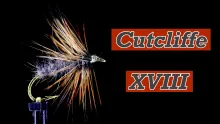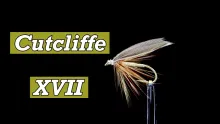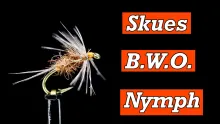The french pediatrician Jean-Paul Pequegnot has written a book about french flies - "Repertoire des Mouches Artificielles Français". 1975. It is translated to english in the last years. He gives among others also descriptions of flies from Britanny.
The french pediatrician Jean-Paul Pequegnot has written a book about french flies - "Repertoire des Mouches Artificielles Francais". 1975. It is translated to english in the last years. He gives among others also descriptions of flies from Britanny. On some of the rivers they had earlier prof. Flyfishermen, in that way, that they earned their living catching trout, seatrout and salmon in public waters on their own flies and sold their catch. Therefore it can be of utmost importance to get a knowledge of their fly-creations. One of the most well-known was Francois LeNy.
My breton friend, Yann Youen Bouglouan (Y.Y.B.) had the previlege to come to know LeNy closely in his last years. He learned the ways of his flytying and after his death inherited his prayerbook, where LeNy, between its pages, stored his materials for tying!
His tying style was quite unique, and I have in my last book "Flies from the Flyleaves of my Diaries" given a short description, which I here shall try to specify more in details: Y.Y.B. uses among others the following pattern:
| Hook | Partridge N - Single Low Water size 2/0. |
| Tying thread | Grey. |
| Tag | Ruby red worsted - teased out and used as dubbing - it can also be bright yellow or deep green. |
| Tail | G.P. crest tied so it curves downwards! |
| Rib | Oval silver tinsel. |
| Body | Wild pig's wool spun to a 'fusil' and rolled around the tying thread. |
| Hackle | Blue dun saddle feather turned over the front half of the body and with more turns just behind the neck of the hook. |
| Wings | G.P. tailfibres mixed with fibres from the feathers just in front of the tail of a Pea-hen - placed on top of the hook - and on both sides tufs of fibres from the same feather from a Pea-hen. |
For the tag is used common worsted - teased out and used as dubbing-material.

He spins it as a 'fusil' - ties it down at the bend and turns it aound the thread and winds it as adubbing. On the front part of the tag he ties the G.P. creast down with its convex side up - opposite the normal way for classic english salmon-flies! Tying it down on top of the wool helps to give it the right curvature.. Then the rib is tied down and the wild pigs wool is like the worsted spun between ones fingers to a fusil - tied down by its point, twisted around the thread and together wound up over the shank to short before the hook-eye - a little nearer the eye, than on normal flies. Then Y.Y.B. ties the hackle down in front and winds it down over the front-half of the body as a palmer-hackle. Catches the tip under the rib, which in wide turns are moved up over the body. Now he treats the body with a stiff toothbrush, so it gets a fluffy appearance.

From a G.P. centre-tailfeather he takes a few fibres - mix them with a few from the mentioned feather from a Pea-hen and tie them down on top of the front-part of the body. Just the same procedure as we tied the tail down with. Obs! The fibres must not stick together - therefore he rolls them between his fingers before they are tied down.

On both sides is small tufts of the same Pea-hen feather tied down and he finishes with a whipfinish knot
The wild pigs wool excists in different shades from light grey to black, and in different textures depending on the age of the animal and the place from where it's taken. Beside that the bretons dye it in different shades of brown and olive using two procedures - either they dye it in an alcoholic solution of picric acid, or they use the brown bulb scales from ordinary onions, which have been stored in acetic acid for a few weeks.
The above tying gives flies with a great amount of life - even in slow flowing water. Also here in Denmark they have been used to great advantage fishing for sea-trout.
© Preben Torp Jacobsen. 'Flyleaves'.
- Log in to post comments







